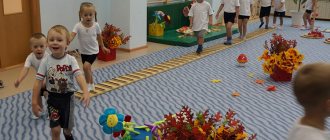Outdoor games. The importance of outdoor games in raising children. Types of outdoor games
Children show special interest in outdoor games They attract them with their emotionality, variety of plots and motor tasks, in which there is an opportunity to satisfy the desire for movement characteristic of children.
In outdoor games, various movements are performed: walking, running, bouncing, jumping, crawling, throwing, throwing, catching, etc. Passionate about the game, children repeat the same movements many times without losing interest in them. This is an important condition for the development and improvement of movements. At the same time, active motor activity of children significantly stimulates the work of a wide variety of muscle groups, increases blood circulation and breathing, and improves metabolism. All this leads to the most complete physical development and improvement of the child’s entire body.
In outdoor games, favorable conditions are created for the development of such motor qualities as dexterity and speed. This is facilitated by the actions of children in constantly changing game situations (the need to dodge so as not to be caught, to run as quickly as possible to catch someone running away, etc.).
Outdoor games differ in content, in the nature of motor tasks, in the ways of organizing children, and in the complexity of the rules.
The following large groups of outdoor games can be distinguished:
1. Story-based games - in which children’s actions are determined by the plot and the role they play. Simple rules are mandatory for all participants and allow you to regulate the behavior of children. A different number of children can participate in story games - from 10 to 25 people.
2. Games without a plot - games like various traps - are most often based on running with catching and dodging. The presence of these elements makes the games especially active, emotional, requiring children to be especially quick and dexterous in their movements.
This group should also include games that are played using a certain set of aids and objects and are based on throwing, throwing, and hitting a target. These games can be played with small groups of children - 2 - 4 people.
3. Game exercises are based on performing certain motor tasks (jumping, throwing, running) and are aimed at training children in certain types of movement.
Game exercises can be organized for a small group of children. Performing movements in them can take place either simultaneously or alternately. It is convenient to carry out such exercises with individual children.
4. Games with elements of competition, simple relay race games are also based on the performance of certain motor tasks and do not have a plot, but they have an element of competition that encourages great activity, the manifestation of various motor and volitional qualities (speed, dexterity, endurance, independence ). This makes them significantly different from plotless games.
Games of this type can be played without division into units or teams, when each child, playing for himself, strives to complete the task as best as possible. These games can also be played with division into units, teams, where the overall result depends on the dexterity, intelligence of each player and the coordination of the actions of the participants of the entire unit.
5. An independent group is represented by games of a sports nature: badminton, games such as basketball, volleyball, football, etc. These games use simple elements of technology and rules of sports games, which are accessible and useful for children of senior preschool age and will be necessary for practicing these types of games in at older ages.
Thanks to the wide variety of outdoor games, you can have a targeted and diverse impact on a child’s development.
The rules of the game have important educational functions. They are present even in the simplest games. The rules create the need to act in accordance with the role: run away from the driver as quickly as possible, jump lightly and high like bunnies or balls, etc. Following simple rules in outdoor games organizes and disciplines children, teaches them to act in concert, to subordinate their desires to common ones. rules, yield to a friend, help each other. If the rules are not followed, the game loses its meaning and ceases to be interesting for children.
In terms of their organization, outdoor games are most often collective; they can unite from 2 to 25 children. Collective games are especially valuable in educational terms. Playing in a group of peers is an important condition for developing the ability to coordinate your movements and behavior with the movements and behavior of other children, find your place in a column, in a circle, without disturbing others, quickly change your place on the playground or in the hall when given a signal, etc. .
Outdoor games provide a wide opportunity for children to communicate with each other. In games, their relationships, attitudes towards various motor tasks, etc. develop and manifest themselves. Often in games, children recite poems and counting rhymes, which contributes to the development of children’s speech.
Outdoor games help to increase children's physical activity, their fullest development and interest in reality.
We recommend watching:
Ball games for schoolchildren
Pedagogical characteristics of outdoor games
Outdoor games for children
Outdoor games for children from 7 to 10 years old. Motor games
Educational and developmental functions of outdoor games. Outdoor play as a social phenomenon
Benefits of outdoor play for children
Probably every adult has retained in their memory vivid pictures from their childhood, when it was impossible to sit at home and wanted to spend all their time outside having fun. Climbing fences and trees, playing catch and hide and seek, exploring nearby construction sites and racing for pigeons seem at first glance to be stupid and fun fun. But in fact, outdoor games help children grow up healthy, strengthen their psyche and develop attention. Modern playgrounds are equipped with everything necessary for the harmonious development and useful pastime of children.
Why do children need outdoor games?
Any game is a need for a child’s body. With the help of games, a child learns to interact with the world around him, realizes his internal needs and develops comprehensively. The game also helps the child to find himself, because it is not for nothing that children often imagine themselves as pilots, astronauts, teachers and doctors. Trying on different professions, the child intuitively tries to find what he likes, arouses interest and succeeds best. Thus, with the help of play, the road to the child’s future is gradually built.
In addition, play is another one of the most important aspects of education. You shouldn’t stop your child from imagining in his story-based games, but you can help him develop both mentally and physically by additionally selecting games for him, and even better, by playing with him.
General development
An outdoor playground engages all five senses and creates an environment for learning. The child explores the world around him, conducts experiments and draws his own conclusions. The game develops his imagination, logical and mathematical thinking, trains memory and intelligence.
Unfortunately, modern children increasingly prefer playing not outdoors, but on the Internet. They spend many hours a day sitting in front of a computer monitor or with a phone in their hands, thereby causing irreparable harm to themselves. The situation is very serious: the problem of childhood obesity has emerged, the immune systems of today's children are weakened, and there is a real danger that the life expectancy of the younger generation will be much shorter than the previous ones. Therefore, parents who are concerned about the health and development of their child try to spend more time with him outdoors and teach him to have an active lifestyle.
What to rely on when choosing a game
First of all, it is necessary to create comfortable conditions for the game. This does not mean that all games should take place on specialized playgrounds or with special props. It is precisely the material side of the issue that in such cases does not play a role at all, since the child’s imagination allows him to make a sword out of any twig, and a desert out of a sandbox. In this situation, it is important to create psychological comfort. The child should feel free, he should have the opportunity to show initiative and independence.
It is imperative to think in advance about how to react to the negative aspects of any game. Here the parents themselves need to try to set a positive example, and try to help the child work through their negative emotions.
And, of course, any game should also be educational. But even here we must not forget about freedom and independence, since the child must come to any conclusions himself, otherwise it will not be effective.
Relay games for preparatory groups
Relay games are team outdoor games with a competitive element. They are held, as a rule, at the end of the main part of a physical education lesson, at sports festivals, or on hikes. The goals of relay games held with children of senior preschool age are as follows:
- general and special warm-up;
- improving the emotional state of children;
- repetition and consolidation of previously learned exercises.
Relay games include a variety of movements - running with throwing, overcoming obstacles, dribbling a ball, etc. It is important that all actions performed by children do not pose any danger.
It is not recommended to include rope climbing, acrobatic somersaults back and forth, or running along a narrow boom in the relay race. The danger comes from such outdoor games in the gym, in which you need to run to the wall and touch it. Some children of preschool age still cannot brake in time. Examples of relay games for preschoolers
| Name of the relay and required items | Final goal | Instructions for outdoor and sports games (relay races) |
| “Sun”, hoop and gymnastic sticks | Developing children's speed, agility, and team abilities | The start of the relay begins with the giving of a signal. The first child takes the hoop and runs to the opposite side of the gym. There the participant leaves the hoop, returns to his team and passes the baton. The second participant takes a gymnastic stick and runs to put a “ray” on the hoop, and then returns. The next participants repeat this action. The first team to “draw” the sun wins |
| "Hat", stand and cap | Development of speed, agility, speed-strength abilities of the legs | At the signal, the first participant from each group runs to a stand installed on the opposite side of the hall, takes off his hat and returns with it to the team. The hat is passed to the second participant. He runs to the counter, puts the item on it, returns and passes the baton. The team that finishes the game the fastest wins. |
Working with children in kindergarten
Experts recommend conducting outdoor games in kindergarten. Sports games are poorly perceived at this age. It is best to offer them to those children who are already preparing for school. How to organize physical education taking into account age? Children from the younger groups are very active and mobile. They love to run, catch up, throw something, but their coordination is poorly developed. Children at this age perceive simple games well. They especially like activities with an invented plot.
One of the suitable games for children from younger groups is “Sparrows and the Car.” They begin it with a story addressed to the imagination of kindergarten students:
“In a large garden there lived little sparrows. All the birds had their own nests in the trees. On sunny days, sparrows flew out of their nests and landed on the ground. They were looking for grains and insects. Sometimes the birds flew up to the puddles and drank some water. One day a red car appeared in the garden and honked: “Beep, beep, beep.” The birds got scared and scattered to their nests.”
After the story, the children are invited to play such a game. At first, the role of the car can be played by a kindergarten teacher or one of the parents if the game is played at home. The children will be the sparrows, and the chairs will be their nests. The rules are as follows: if the car does not honk, the young participants in the game get up from their chairs, sit down on the floor and demonstrate the search for grains or water; when the car starts beeping, the children quickly run to the chairs and sit on them.
Kindergarten pupils from the middle groups are offered more complex outdoor games. Classes with a certain fictional plot continue to be actively conducted. Fairy-tale play images encourage children to perform certain roles. Suitable story games are “Kittens and Puppies”, “Mousetrap”. Gradually, children begin to become familiar with non-story games.
Children from older groups, in addition to plot and non-story games, are offered games with elements of competition. Pupils are selected with opponents who are equal in physical strength and development of motor skills (that is, they have an equal chance of winning). In preparatory groups for school, relay races, various sports games and exercises are additionally conducted.
Physical health
Outdoor games have a beneficial effect on the physical health of children:
- the immune system is strengthened and the body’s resistance to colds increases;
- physical activity prevents obesity from developing;
- while playing outside, the child receives the necessary dose of vitamin D, which is indispensable during the period of active growth and formation of the baby’s bone tissue;
- Walking and playing outdoors help the proper functioning of internal organs and the brain.
Safety precautions for sports and outdoor games and principles of their implementation
When working with children of any age, safety precautions must be strictly observed. Ignoring it can lead to harm to health (illness, injury). The safety rules are as follows:
- The venue for sports and outdoor games must be checked. If the lesson is held outdoors, the surface should be non-slip. If games are planned to be organized in a building, then care should be taken to ensure that the room is well lit and ventilated.
- First, the rules of a sports, outdoor game are explained to the children. Before the game, the teacher, teacher or one of the parents also reminds them to avoid collisions, jolts and impacts. If someone falls, you need to stop the activity and help that child get to his feet.
- Before the start of the game, the presence of a tracksuit and sports shoes is checked, and sports equipment is inspected.
When working with children in the process of physical education, it is important to observe not only safety precautions for sports and outdoor games, but also the principles of their implementation. Only if this condition is met will the exercises benefit your health and not cause harm. Here is a list of basic principles:
- taking into account age development;
- systematic;
- availability;
- gradualism;
- alternating loads;
- visibility.
Important attention should be paid to the fact that not all children successfully master any movements, exercises, or tactics. Weak players need to be treated very tactfully, without requiring them to follow complex rules. Otherwise, such children may suffer harm to both physical and mental health.
If some students do not succeed in something, this does not mean that they are lazy, disobedient, misunderstood something, or they simply do not like the proposed topics of outdoor and sports games. Failures are often manifestations of the individual characteristics of the body. The task of educators, teachers and parents in this case is not to demand that things be done that cannot be done, but to patiently strive to ensure that weak children gradually develop and approach the general level of gaming readiness of the team.




